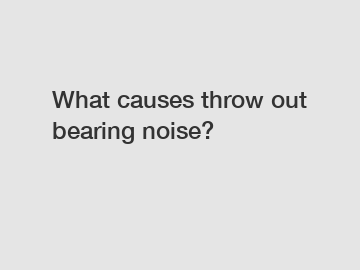What causes throw out bearing noise?
What causes throw out bearing noise?
The throw out bearing is an essential component of a manual transmission system. It allows the smooth operation of the clutch by enabling the release of the clutch disc from the flywheel when the clutch pedal is depressed. However, like any mechanical part, the throw out bearing can develop problems over time, resulting in various noises. In this article, we will discuss the factors that cause throw out bearing noise and the possible solutions to rectify them.
1. Lack of lubrication:

One of the leading causes of throw out bearing noise is improper lubrication. The throw out bearing relies on lubrication to reduce friction and enable smooth operation. When the lubricant becomes insufficient or breaks down, it can lead to grinding or squealing noises when engaging or disengaging the clutch. Regular maintenance and ensuring the use of the correct lubricant can help prevent this issue.
2. Worn-out throw out bearing:
Over time, the throw out bearing can wear out due to continuous use and friction. When the bearing wears down, it can create a rumbling or growling noise that becomes more pronounced as the clutch pedal is depressed. A worn-out throw out bearing should be promptly replaced to prevent further damage to the clutch system and ensure smooth operation.
3. Misalignment of the clutch fork:
The clutch fork is responsible for engaging and disengaging the throw out bearing against the pressure plate. When the clutch fork becomes misaligned, it can cause the bearing to rub against the pressure plate unevenly, resulting in a whining or rattling noise. Adjusting the clutch fork's position or replacing a damaged fork can eliminate this noise.
4. Faulty clutch release mechanism:
The clutch release mechanism consists of various components that work together to operate the throw out bearing. If any of these components, such as the hydraulic cylinder, release lever, or pivot ball, develop faults, it can lead to throw out bearing noise. A hydraulic leak or a worn-out release lever can cause the bearing to make loud clicking or rattling noises. Inspecting and repairing or replacing faulty components is vital to resolving this issue.
5. High mileage or extreme driving conditions:
Vehicles with high mileage or those frequently driven in harsh conditions may experience throw out bearing noise more frequently. Continuous use puts additional stress on the bearing, which can accelerate wear and lead to premature failure. Regular maintenance, including inspection and lubrication, becomes even more critical in such situations to avoid costly repairs.
In conclusion, throw out bearing noise can be caused by various factors, including lack of lubrication, worn-out bearings, misalignment of the clutch fork, and faulty clutch release mechanisms. Preventive maintenance, regular inspections, and timely repairs are essential for ensuring the smooth operation and longevity of the throw out bearing and the overall clutch system. If you notice any unusual noises during clutch operation, it is advisable to consult a qualified mechanic to diagnose and rectify the issue promptly. By addressing these problems early on, you can avoid further damage and expensive repairs down the line.
For more information, please visit shaft cross, cross shaft joint, deep groove ball bearing advantages.

Comments
0